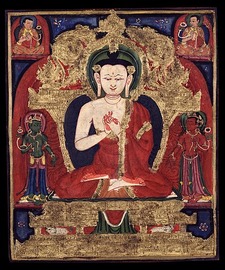en.wikipedia.org
Always private
DuckDuckGo never tracks your searches.
Learn MoreYou can hide this reminder in Search Settings
All regions
Argentina
Australia
Austria
Belgium (fr)
Belgium (nl)
Brazil
Bulgaria
Canada (en)
Canada (fr)
Catalonia
Chile
China
Colombia
Croatia
Czech Republic
Denmark
Estonia
Finland
France
Germany
Greece
Hong Kong
Hungary
Iceland
India (en)
Indonesia (en)
Ireland
Israel (en)
Italy
Japan
Korea
Latvia
Lithuania
Malaysia (en)
Mexico
Netherlands
New Zealand
Norway
Pakistan (en)
Peru
Philippines (en)
Poland
Portugal
Romania
Russia
Saudi Arabia
Singapore
Slovakia
Slovenia
South Africa
Spain (ca)
Spain (es)
Sweden
Switzerland (de)
Switzerland (fr)
Taiwan
Thailand (en)
Turkey
Ukraine
United Kingdom
US (English)
US (Spanish)
Vietnam (en)
Safe search: moderate
Strict
Moderate
Off
Any time
- Was this helpful?
- A skilled thangka artist will generally select from a variety of predesigned items to include in the composition, ranging from alms bowls and animals, to the shape, size, and angle of a figure's eyes, nose, and lips. The process seems very methodical, but often requires deep understanding of the symbolism involved to capture the spirit of it. ...
artsandculture.google.com
Acrylic paints have largely replaced traditional natural pigments and real gold dust that were used earlier in thangka painting. The painting of a thangka is done with fine brushes. The artist blends different hues and adds details to give depth to the image, and a fine thangka can take a few months to complete.enlightenmentthangka.com
Enlightenment Thangka
https://enlightenmentthangka.com › blogs › thangka › thangka-painting
Thangka means "thing that one unrolls" or "something that can be rolled up" in classical Tibetan, alluding to the 'scroll painting' nature of thangkas. These paintings are an integral part of Buddhism and a unique art form combining art and spirituality. An ancient art form, Thangka painting roots back thousands of years and has been preserved to date through generational practice.britannica.com
thang-ka, (Tibetan: "something rolled up"), Tibetan religious painting or drawing on woven material, usually cotton; it has a bamboo-cane rod pasted on the bottom edge by which it can be rolled up.. Thang-kas are essentially aids for meditation, though they may be hung in temples or at family altars, carried in religious processions, or used to illustrate sermons.Author:The Editors of Encyclopaedia Britannicanorbulingka.org
Norbulingka Institute
https://norbulingka.org › pages › thangka-painting-traditional-buddhist-art
A thangka painter's goal is to create images that inspire the viewer. Unlike Western works of art, which are the product of the artist's personal ingenuity, Tibetan religious art is regarded as a way to communicate transcendental qualities to practitioners, the painter being the vessel.thangka-mandala.com
thangka-mandala.com
https://www.thangka-mandala.com › thangkas
Jul 30, 2023Dating back to the 7th century A.D, thangka painting is unequivocally one of the greatest art forms of Asia, and is considered to be part of the Abhidharma or "Art of Enlightenment". This means that thangkas are considered Buddhist iconography, each painting will symbolically represent divinities and passages based on the teachings of the ...guidetibet.com
guidetibet.com
https://guidetibet.com › thangka
Oct 25, 2024Thangka, also known as "Tangga" and "Tangka", is a kind of colored scroll painting embroidered or painted on cloth, silk or paper.In the process of development, Gama Gachi painting school based on the tradition, bold innovation, absorb the essence of Han painters meticulous brushwork heavy color techniques, pay attention to lyrical freehand, pay attention to color contrast, form a ...exploretibet.com
The transmission of Thangka painting skills occurred within monastic communities, fostering a lineage of artists who meticulously preserved and refined the craft. This historical continuity ensured that Thangkas retained their authenticity and cultural significance through the centuries. Cultural Importance of Tibetan Thangka Paintingseducation.asianart.org
In Tibet, religious paintings come in several forms, including wall paintings, thangkas (sacred pictures that can be rolled up), and miniatures for ritual purposes or for placement in household shrines. Some thangka artists traveled all over Tibet, working for monasteries as well as for private patrons.artsandculture.google.com
This thangka painting is centered on Shakyamuni, beneath whom standing his two disciples, Sariputta and Maudgalyayana both holding a khakkhara in one hand and a Buddha bowl in the other. The three are surrounded by the Eighteen Arahants, sixteen arahants with two aryas actually, who were introduced to Tibetan Buddhism from the Han Buddhism as a ...Can’t find what you’re looking for?
Help us improve DuckDuckGo searches with your feedback
